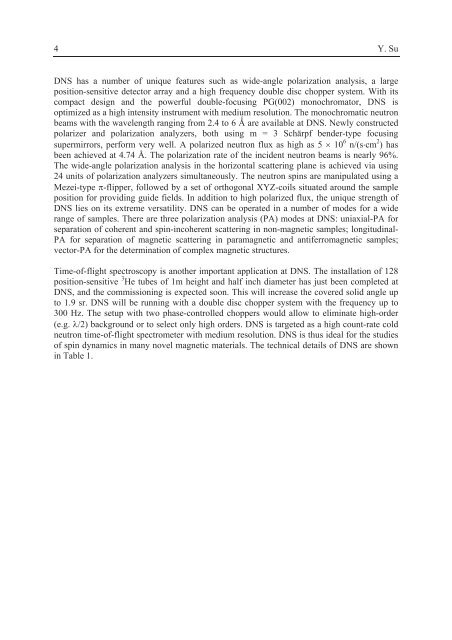Neutron Scattering - JUWEL - Forschungszentrum Jülich
Neutron Scattering - JUWEL - Forschungszentrum Jülich
Neutron Scattering - JUWEL - Forschungszentrum Jülich
You also want an ePaper? Increase the reach of your titles
YUMPU automatically turns print PDFs into web optimized ePapers that Google loves.
4 Y. Su<br />
DNS has a number of unique features such as wide-angle polarization analysis, a large<br />
position-sensitive detector array and a high frequency double disc chopper system. With its<br />
compact design and the powerful double-focusing PG(002) monochromator, DNS is<br />
optimized as a high intensity instrument with medium resolution. The monochromatic neutron<br />
beams with the wavelength ranging from 2.4 to 6 � are available at DNS. Newly constructed<br />
polarizer and polarization analyzers, both using m = 3 Schärpf bender-type focusing<br />
supermirrors, perform very well. A polarized neutron flux as high as 5 � 10 6 n/(s�cm 2 ) has<br />
been achieved at 4.74 Å. The polarization rate of the incident neutron beams is nearly 96%.<br />
The wide-angle polarization analysis in the horizontal scattering plane is achieved via using<br />
24 units of polarization analyzers simultaneously. The neutron spins are manipulated using a<br />
Mezei-type �-flipper, followed by a set of orthogonal XYZ-coils situated around the sample<br />
position for providing guide fields. In addition to high polarized flux, the unique strength of<br />
DNS lies on its extreme versatility. DNS can be operated in a number of modes for a wide<br />
range of samples. There are three polarization analysis (PA) modes at DNS: uniaxial-PA for<br />
separation of coherent and spin-incoherent scattering in non-magnetic samples; longitudinal-<br />
PA for separation of magnetic scattering in paramagnetic and antiferromagnetic samples;<br />
vector-PA for the determination of complex magnetic structures.<br />
Time-of-flight spectroscopy is another important application at DNS. The installation of 128<br />
position-sensitive 3 He tubes of 1m height and half inch diameter has just been completed at<br />
DNS, and the commissioning is expected soon. This will increase the covered solid angle up<br />
to 1.9 sr. DNS will be running with a double disc chopper system with the frequency up to<br />
300 Hz. The setup with two phase-controlled choppers would allow to eliminate high-order<br />
(e.g. �/2) background or to select only high orders. DNS is targeted as a high count-rate cold<br />
neutron time-of-flight spectrometer with medium resolution. DNS is thus ideal for the studies<br />
of spin dynamics in many novel magnetic materials. The technical details of DNS are shown<br />
in Table 1.

















